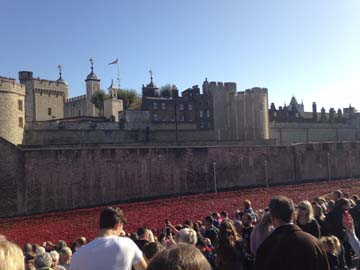Armistice Day, November 11.
Bright red poppies have appeared in their thousands to adorn the spaces around the Tower of London. The symbolism evokes the image of poppies springing up from destruction and decay in Belgium’s Flanders Fields, sites of many of the ‘Great War’s’ bloodiest battlefields. The scene was memorably written up in a war poem by Canadian army doctor John McCrae: “In Flanders fields the poppies blow/Between the crosses row on row.”
McCrae had noticed that the resilient red corn poppy was the first plant to flourish in the churned-up landscape. The poem, written in 1915 shortly after McCrae buried his friend, struck a universal note and thus began poppy popularity across the English-speaking world.
The poppy takes the memories back to World War I, for some to honour the war dead and in earlier days to raise funds for survivors – now likewise for the remaining veterans. For others though, on top of giving honour to the fallen who did what they deemed best at the time, the overwhelming wish is that such violence of man-on-man is not repeated.










